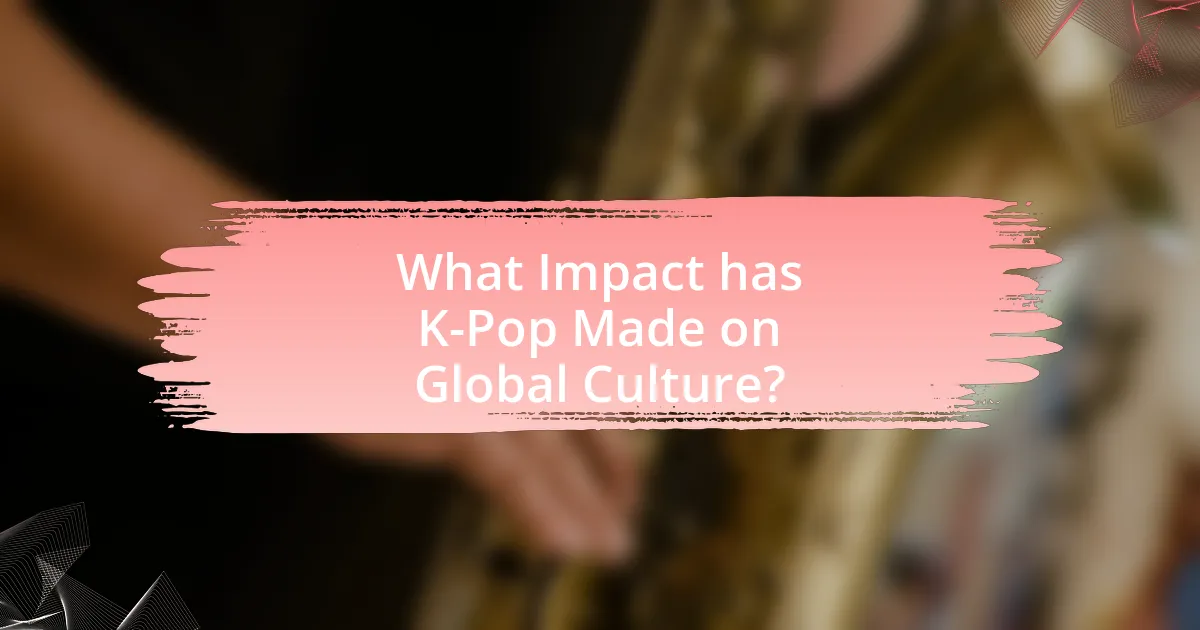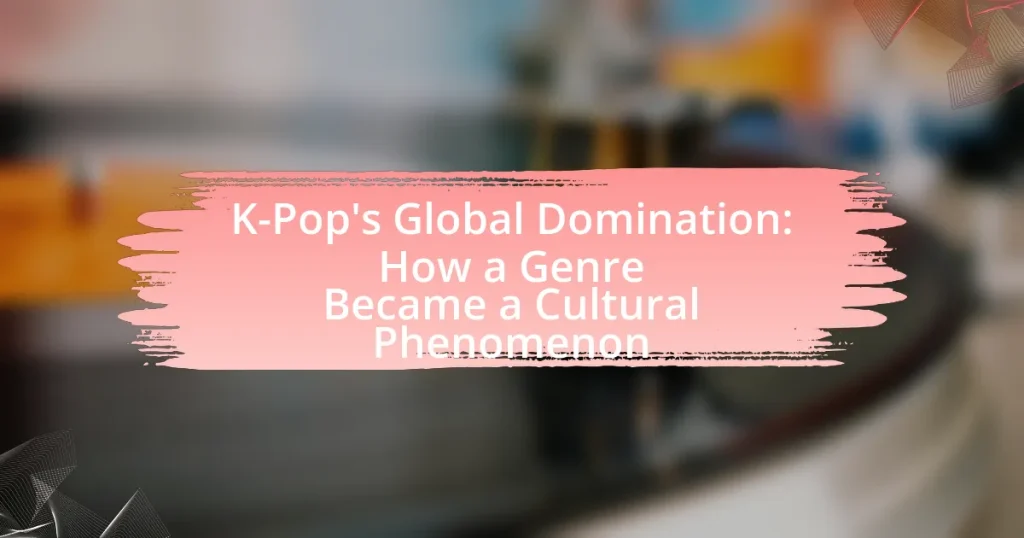K-Pop, or Korean Pop music, is a genre that combines various musical styles and has gained significant global influence, particularly through groups like BTS and BLACKPINK. Originating in the early 1990s, K-Pop has evolved into a cultural phenomenon characterized by high production values, catchy melodies, and visually striking performances. The article explores K-Pop’s origins, its transition from local to global appeal, the defining characteristics of its music and performances, and its impact on global culture, including fashion and beauty standards. Additionally, it addresses the challenges faced by the industry, such as mental health issues among idols and the need for continuous innovation to maintain its international presence.

What is K-Pop and Why is it Significant?
K-Pop, or Korean Pop music, is a genre that blends various musical styles, including pop, hip-hop, R&B, and electronic dance music, characterized by its catchy melodies, high production values, and visually striking performances. Its significance lies in its global influence, as K-Pop has transcended cultural boundaries, with groups like BTS and BLACKPINK achieving international success, evidenced by BTS becoming the first K-Pop act to top the Billboard Hot 100 chart in 2020. This genre has not only reshaped the music industry but has also fostered a dedicated global fanbase, contributing to the rise of the Korean Wave, or Hallyu, which promotes Korean culture worldwide.
How did K-Pop originate and evolve over time?
K-Pop originated in South Korea in the early 1990s, influenced by Western pop music and the country’s own musical traditions. The genre began to take shape with the debut of groups like Seo Taiji and Boys in 1992, who integrated rap, rock, and dance into their music, setting a precedent for future K-Pop acts. Over time, K-Pop evolved through the establishment of entertainment companies that trained artists in singing, dancing, and performance, leading to the creation of polished idol groups.
By the late 1990s and early 2000s, K-Pop began to gain popularity across Asia, with groups like H.O.T. and S.E.S. paving the way for the genre’s expansion. The introduction of the internet and social media in the 2010s further propelled K-Pop’s global reach, allowing fans worldwide to access music videos and engage with artists directly. This evolution was marked by the rise of groups such as BTS and BLACKPINK, who achieved unprecedented international success, breaking records on platforms like Billboard and YouTube.
The genre’s growth is evidenced by its increasing presence in global music charts, sold-out international tours, and collaborations with Western artists, solidifying K-Pop as a significant cultural phenomenon.
What cultural influences shaped the early development of K-Pop?
The early development of K-Pop was shaped by a blend of Western musical influences, traditional Korean music, and the rise of technology in the 1990s. Western genres such as pop, hip-hop, and R&B significantly impacted K-Pop’s sound and production styles, as seen in the incorporation of catchy melodies and dance beats. Traditional Korean music, including pansori and folk songs, provided cultural context and authenticity, enriching the genre’s identity. Additionally, the advent of cable television and the internet facilitated the dissemination of K-Pop, allowing artists to reach wider audiences and adopt global trends. This combination of influences laid the groundwork for K-Pop’s unique sound and its eventual global appeal.
How did the genre transition from local to global appeal?
K-Pop transitioned from local to global appeal through strategic marketing, social media engagement, and international collaborations. The genre’s agencies, such as SM Entertainment and YG Entertainment, invested heavily in producing high-quality music videos and engaging content that resonated with a global audience. The use of platforms like YouTube allowed K-Pop artists to reach millions worldwide, exemplified by Psy’s “Gangnam Style,” which became a viral hit, garnering over 4 billion views. Additionally, collaborations with Western artists, such as BTS’s partnership with Halsey on “Boy With Luv,” further expanded K-Pop’s reach and acceptance in international markets. These efforts collectively contributed to K-Pop’s rise as a significant cultural phenomenon beyond South Korea.
What are the defining characteristics of K-Pop music and performance?
K-Pop music and performance are characterized by their catchy melodies, high production values, and intricate choreography. The genre often blends various musical styles, including pop, hip-hop, R&B, and electronic dance music, creating a diverse sound that appeals to a global audience. Additionally, K-Pop performances are known for their visually stunning aesthetics, which include elaborate stage designs, colorful costumes, and synchronized dance routines. The emphasis on visual appeal is supported by the use of music videos that often feature cinematic storytelling and high-quality production, contributing to the overall entertainment value. These characteristics have played a significant role in K-Pop’s rise as a cultural phenomenon, evidenced by the genre’s ability to attract millions of fans worldwide and dominate music charts across different countries.
How do musical elements differentiate K-Pop from other genres?
Musical elements differentiate K-Pop from other genres through its unique blend of diverse styles, catchy melodies, and high production values. K-Pop incorporates various genres such as hip-hop, R&B, electronic dance music, and rock, creating a hybrid sound that appeals to a wide audience. The use of intricate choreography, visually stunning music videos, and polished vocal performances further enhances its distinctiveness. Additionally, K-Pop songs often feature hooks and choruses designed for maximum catchiness, which is supported by the genre’s emphasis on visual aesthetics and storytelling in performances. This combination of musical diversity and multimedia presentation sets K-Pop apart from other music genres.
What role do visuals and choreography play in K-Pop’s appeal?
Visuals and choreography are central to K-Pop’s appeal, as they create a captivating and immersive experience for audiences. The striking visuals, including fashion, makeup, and stage design, enhance the overall aesthetic and draw viewers in, while intricate choreography showcases the performers’ talent and energy, making the performances memorable. Research indicates that K-Pop music videos often feature high production values, with some videos costing upwards of $1 million, which emphasizes the importance of visuals in attracting global audiences. Additionally, the synchronization and complexity of choreography contribute to the genre’s dynamic nature, making it a visual spectacle that resonates with fans worldwide.
Why has K-Pop gained such a massive international following?
K-Pop has gained a massive international following due to its unique blend of catchy music, high-quality production, and visually stunning performances. The genre’s appeal is amplified by the use of social media platforms, which facilitate global fan engagement and promote artists worldwide. For instance, BTS, one of the most prominent K-Pop groups, broke records by becoming the first Korean act to top the Billboard Hot 100 chart in 2020, showcasing the genre’s widespread popularity. Additionally, K-Pop’s incorporation of diverse musical styles and its emphasis on elaborate choreography attract a broad audience, further solidifying its international presence.
What marketing strategies have contributed to K-Pop’s global reach?
K-Pop’s global reach has been significantly enhanced by strategic use of social media, targeted international marketing, and collaborations with global artists. Social media platforms like YouTube and Twitter have allowed K-Pop groups to share music videos and engage with fans worldwide, leading to billions of views and a dedicated international fanbase. For instance, BTS’s “Dynamite” music video garnered over 100 million views within 24 hours of its release, showcasing the power of digital platforms in amplifying reach. Additionally, K-Pop agencies often employ targeted marketing campaigns that focus on specific international markets, tailoring content to resonate with diverse audiences. Collaborations with Western artists, such as BLACKPINK’s partnership with Lady Gaga, further enhance visibility and appeal, bridging cultural gaps and attracting a broader audience. These strategies collectively contribute to K-Pop’s status as a global cultural phenomenon.
How do social media and streaming platforms influence K-Pop’s popularity?
Social media and streaming platforms significantly enhance K-Pop’s popularity by providing artists with direct access to global audiences and facilitating fan engagement. Platforms like YouTube, Twitter, and Instagram allow K-Pop groups to share music videos, behind-the-scenes content, and interact with fans in real-time, which fosters a dedicated fanbase. For instance, BTS’s music video for “Dynamite” amassed over 100 million views within 24 hours of its release, showcasing the power of streaming platforms in amplifying reach. Additionally, social media trends, such as viral challenges and hashtags, further promote K-Pop songs, leading to increased visibility and chart performance. The integration of these digital tools has transformed K-Pop into a worldwide phenomenon, evidenced by its presence on global music charts and award shows.

What Impact has K-Pop Made on Global Culture?
K-Pop has significantly influenced global culture by promoting Korean language, fashion, and entertainment worldwide. The genre has led to a surge in interest in South Korean culture, evidenced by the Korean Wave, or Hallyu, which has seen a 200% increase in the number of international fans from 2010 to 2020. K-Pop groups like BTS and BLACKPINK have broken records on global music charts, with BTS becoming the first South Korean act to top the Billboard Hot 100 in 2020. This cultural phenomenon has also sparked a rise in Korean language learning, with a reported 30% increase in students studying Korean abroad. Additionally, K-Pop’s unique blend of music, choreography, and visual aesthetics has influenced global fashion trends, as seen in collaborations between K-Pop artists and major fashion brands.
How has K-Pop influenced fashion and lifestyle trends worldwide?
K-Pop has significantly influenced fashion and lifestyle trends worldwide by popularizing unique styles and aesthetics that resonate with global audiences. The genre’s artists often showcase bold, eclectic fashion choices, which have led to increased interest in streetwear, vibrant colors, and gender-fluid clothing. For instance, the rise of groups like BTS and BLACKPINK has resulted in collaborations with major fashion brands such as Dior and Chanel, further solidifying K-Pop’s impact on the fashion industry. Additionally, social media platforms like Instagram and TikTok amplify these trends, allowing fans to emulate their favorite idols’ styles, thus creating a global fashion movement rooted in K-Pop culture.
What are some notable fashion collaborations stemming from K-Pop?
Notable fashion collaborations stemming from K-Pop include partnerships between popular groups and high-profile brands such as BTS with Louis Vuitton, BLACKPINK with Dior, and EXO with Gucci. BTS’s collaboration with Louis Vuitton in 2021 marked a significant moment as they became global ambassadors, showcasing the intersection of music and luxury fashion. BLACKPINK’s partnership with Dior in 2021 highlighted their influence in the fashion industry, as they attended major events wearing exclusive designs. EXO’s collaboration with Gucci further solidified K-Pop’s impact on fashion, as the group frequently wore the brand’s pieces, enhancing its visibility in the Asian market. These collaborations demonstrate K-Pop’s ability to shape global fashion trends and elevate brand recognition.
How do K-Pop idols shape beauty standards in different cultures?
K-Pop idols significantly shape beauty standards in different cultures by promoting specific aesthetics that emphasize features such as fair skin, slim bodies, and distinct fashion styles. This influence is evident as K-Pop’s global reach introduces these ideals to diverse audiences, leading to the adoption of similar beauty practices and preferences in various regions. For instance, research indicates that the popularity of K-Pop has led to increased demand for cosmetic products and procedures that align with these standards, particularly in Southeast Asia and Western countries. A study published in the Journal of Consumer Culture highlights how K-Pop’s visual culture encourages fans to emulate idol looks, thereby altering local beauty norms and expectations.
What role does K-Pop play in cultural exchange and diplomacy?
K-Pop plays a significant role in cultural exchange and diplomacy by promoting South Korean culture globally and fostering international relationships. The genre’s widespread popularity has led to increased interest in South Korean language, fashion, and traditions, facilitating cultural dialogue between South Korea and other nations. For instance, the Korean Wave, or Hallyu, has resulted in South Korea’s cultural exports reaching over $10 billion in 2020, highlighting its impact on global cultural dynamics. Additionally, K-Pop acts often participate in international events and collaborations, enhancing soft power and diplomatic ties, as seen with BTS’s involvement in the United Nations General Assembly to advocate for global issues.
How has K-Pop contributed to the spread of Korean culture globally?
K-Pop has significantly contributed to the spread of Korean culture globally by popularizing Korean music, fashion, and language through its widespread appeal and innovative marketing strategies. The genre has amassed a massive international fanbase, with groups like BTS and BLACKPINK achieving record-breaking sales and streaming numbers, which have introduced millions to Korean cultural elements. For instance, BTS’s “Dynamite” became the first all-South Korean song to top the Billboard Hot 100 chart in 2020, showcasing the global reach of K-Pop. Additionally, K-Pop’s integration of traditional Korean aesthetics in music videos and performances has sparked interest in Korean history and customs, further enhancing cultural exchange.
What initiatives have K-Pop artists taken to promote cultural understanding?
K-Pop artists have taken several initiatives to promote cultural understanding, including collaborations with international artists, participation in global charity events, and the incorporation of diverse cultural elements in their music and performances. For instance, BTS, a leading K-Pop group, has collaborated with artists like Halsey and Ed Sheeran, which not only blends musical styles but also fosters cross-cultural dialogue. Additionally, K-Pop groups often engage in charity work, such as participating in the “Love Myself” campaign with UNICEF, which aims to end violence against children and promote global awareness. These efforts demonstrate K-Pop’s commitment to bridging cultural gaps and fostering a sense of global community.
Why is K-Pop considered a model for other music industries?
K-Pop is considered a model for other music industries due to its innovative marketing strategies, high production quality, and strong fan engagement. The genre has successfully integrated social media and digital platforms to reach a global audience, exemplified by the rapid rise of groups like BTS, whose album “Map of the Soul: 7” sold over 4 million copies in its first week, setting a record for the highest first-week sales in South Korea. Additionally, K-Pop’s emphasis on visually captivating music videos and choreographed performances has set new standards for entertainment value, influencing artists worldwide to adopt similar approaches. The genre’s ability to create a dedicated fanbase, known as “ARMY” for BTS, showcases effective community-building tactics that other music industries are now trying to replicate.
What lessons can other genres learn from K-Pop’s success?
Other genres can learn the importance of a strong visual identity and strategic marketing from K-Pop’s success. K-Pop artists often combine high-quality music production with visually captivating music videos and performances, which enhances audience engagement. For instance, the global success of BTS can be attributed to their meticulous branding and the use of social media platforms to connect with fans, resulting in a dedicated international fanbase. Additionally, K-Pop’s emphasis on training and development of artists ensures high performance standards, which can inspire other genres to invest in artist development and create a more polished product.
How does K-Pop’s business model differ from traditional music industries?
K-Pop’s business model significantly differs from traditional music industries by emphasizing a multi-faceted approach that integrates music production, artist training, and extensive marketing strategies. Unlike traditional models that primarily focus on album sales and radio play, K-Pop companies invest heavily in the development of idols through rigorous training programs, often lasting several years, which includes vocal, dance, and language instruction. This investment creates highly polished performers who are marketed not just as musicians but as comprehensive entertainment packages, appealing to fans through various media platforms, merchandise, and live performances.
Additionally, K-Pop’s use of social media and fan engagement strategies, such as interactive content and fan meetings, fosters a strong community around the artists, enhancing loyalty and driving sales across multiple revenue streams, including concerts, merchandise, and digital content. This contrasts with traditional music industries that typically rely on physical album sales and radio airplay for revenue generation. The success of K-Pop groups like BTS, who generated over $4 billion in economic impact in 2019 alone, exemplifies the effectiveness of this model in creating a global fanbase and maximizing revenue opportunities.

What are the Challenges and Future of K-Pop?
The challenges facing K-Pop include intense competition, mental health issues among idols, and the need for continuous innovation to maintain global interest. Competition arises from both domestic and international music markets, with numerous genres vying for listener attention. Mental health concerns have been highlighted by incidents involving K-Pop idols, leading to calls for better support systems within the industry. Additionally, as K-Pop has reached a global audience, the pressure to innovate and adapt to diverse musical tastes is paramount for its future sustainability. The future of K-Pop hinges on addressing these challenges while continuing to expand its cultural influence and audience engagement.
What controversies have surrounded the K-Pop industry?
The K-Pop industry has faced several controversies, including issues related to mental health, exploitation of artists, and cultural appropriation. Mental health concerns have arisen due to the intense pressure on idols to maintain a perfect image, leading to tragic incidents such as the suicides of prominent figures like Sulli and Jonghyun. Exploitation is evident in the rigorous training systems and long contracts that often limit artists’ personal freedoms and financial earnings. Additionally, cultural appropriation controversies have emerged when K-Pop groups incorporate elements from various cultures without proper acknowledgment, sparking debates about respect and representation. These controversies highlight the darker aspects of the industry’s rapid growth and global influence.
How do issues of mental health and pressure affect K-Pop idols?
Issues of mental health and pressure significantly affect K-Pop idols, often leading to anxiety, depression, and burnout. The intense training, long working hours, and public scrutiny create an environment where idols face immense stress. For instance, a study published in the Journal of Korean Medical Science in 2020 highlighted that 40% of K-Pop idols reported experiencing mental health issues, with many citing the pressure to maintain a perfect image and meet high expectations from fans and management. This pressure can result in severe consequences, including withdrawal from the industry, as seen in cases like Sulli and Jonghyun, who both struggled with mental health challenges.
What are the implications of the intense training system in K-Pop?
The intense training system in K-Pop leads to both positive and negative implications for artists and the industry. On the positive side, this rigorous training cultivates highly skilled performers who excel in singing, dancing, and stage presence, contributing to the genre’s global appeal. For instance, trainees often undergo years of vocal and dance training, which enhances their marketability and performance quality, as seen in successful groups like BTS and BLACKPINK.
Conversely, the intense training can result in significant mental and physical stress for the artists. Many trainees face harsh competition, long hours, and pressure to conform to strict industry standards, which can lead to burnout and mental health issues. Reports indicate that some K-Pop idols experience anxiety and depression due to these pressures, highlighting the darker side of the training system.
Overall, while the training system produces exceptional talent that fuels K-Pop’s global success, it also raises concerns about the well-being of the artists involved.
How is K-Pop adapting to changing global music trends?
K-Pop is adapting to changing global music trends by incorporating diverse musical styles and collaborating with international artists. This genre has increasingly embraced elements from hip-hop, R&B, and electronic dance music, reflecting the evolving tastes of a global audience. For instance, collaborations with Western artists like Dua Lipa and Nicki Minaj have expanded K-Pop’s reach and appeal. Additionally, K-Pop agencies are leveraging social media platforms like TikTok to engage younger audiences, which has become crucial for music promotion in the digital age. The genre’s ability to blend various influences while maintaining its unique identity demonstrates its responsiveness to global music trends.
What innovations are emerging within the K-Pop genre?
Innovations emerging within the K-Pop genre include the integration of advanced technology in music production, such as artificial intelligence for songwriting and virtual reality for immersive fan experiences. These innovations enhance the creative process and engage audiences in novel ways. For instance, AI-generated music has been utilized by various K-Pop artists, allowing for unique soundscapes that appeal to diverse listeners. Additionally, the use of virtual reality concerts has gained traction, especially during the COVID-19 pandemic, enabling fans to experience live performances from home, thus expanding the reach of K-Pop globally.
How are K-Pop artists engaging with their international fanbase?
K-Pop artists are engaging with their international fanbase through social media platforms, global tours, and multilingual content. By utilizing platforms like Twitter, Instagram, and TikTok, artists can interact directly with fans, share behind-the-scenes content, and promote their music globally. Additionally, K-Pop groups often embark on world tours, allowing them to perform in various countries and connect with fans in person. The use of multilingual lyrics and subtitles in music videos further enhances accessibility, making it easier for non-Korean speakers to enjoy and understand the music. This strategy has contributed to the genre’s rapid global expansion, evidenced by the significant increase in international fan engagement and concert attendance, with BTS alone selling over 1.5 million tickets for their world tour in 2019.
What can fans do to support K-Pop artists sustainably?
Fans can support K-Pop artists sustainably by purchasing official merchandise and music directly from the artists’ platforms, which ensures that a larger portion of the revenue goes to the artists. This method not only provides financial support but also encourages ethical consumption practices. According to a report by the Korea Creative Content Agency, direct sales from official channels significantly contribute to artists’ income, allowing them to invest in future projects and maintain their careers. Additionally, fans can engage in streaming music on licensed platforms, as streaming counts contribute to chart rankings and visibility, further enhancing the artists’ reach and success.
How can fans promote positive practices within the K-Pop community?
Fans can promote positive practices within the K-Pop community by actively engaging in respectful discourse and supporting mental health initiatives. By fostering an environment of kindness and understanding, fans can counteract negativity and toxicity often seen in online spaces. For instance, campaigns like “Love Myself,” initiated by BTS in partnership with UNICEF, highlight the importance of self-love and mental well-being, demonstrating how fan support can lead to meaningful social change. Additionally, fans can organize charity events and fundraisers, which not only benefit communities but also reflect the values of the artists they admire, thereby reinforcing a culture of positivity and support within the K-Pop fandom.
What are effective ways to engage with K-Pop culture responsibly?
Effective ways to engage with K-Pop culture responsibly include supporting artists through legitimate platforms, respecting cultural nuances, and promoting positive fan interactions. Supporting artists through official music streaming services and merchandise ensures that creators receive fair compensation, which is crucial in the music industry. Understanding and respecting the cultural context of K-Pop, including its roots in South Korean society, helps foster appreciation rather than appropriation. Additionally, encouraging positive interactions among fans, such as avoiding toxic behavior and promoting inclusivity, contributes to a healthier fan community. These practices not only enhance personal engagement but also support the broader K-Pop ecosystem.


